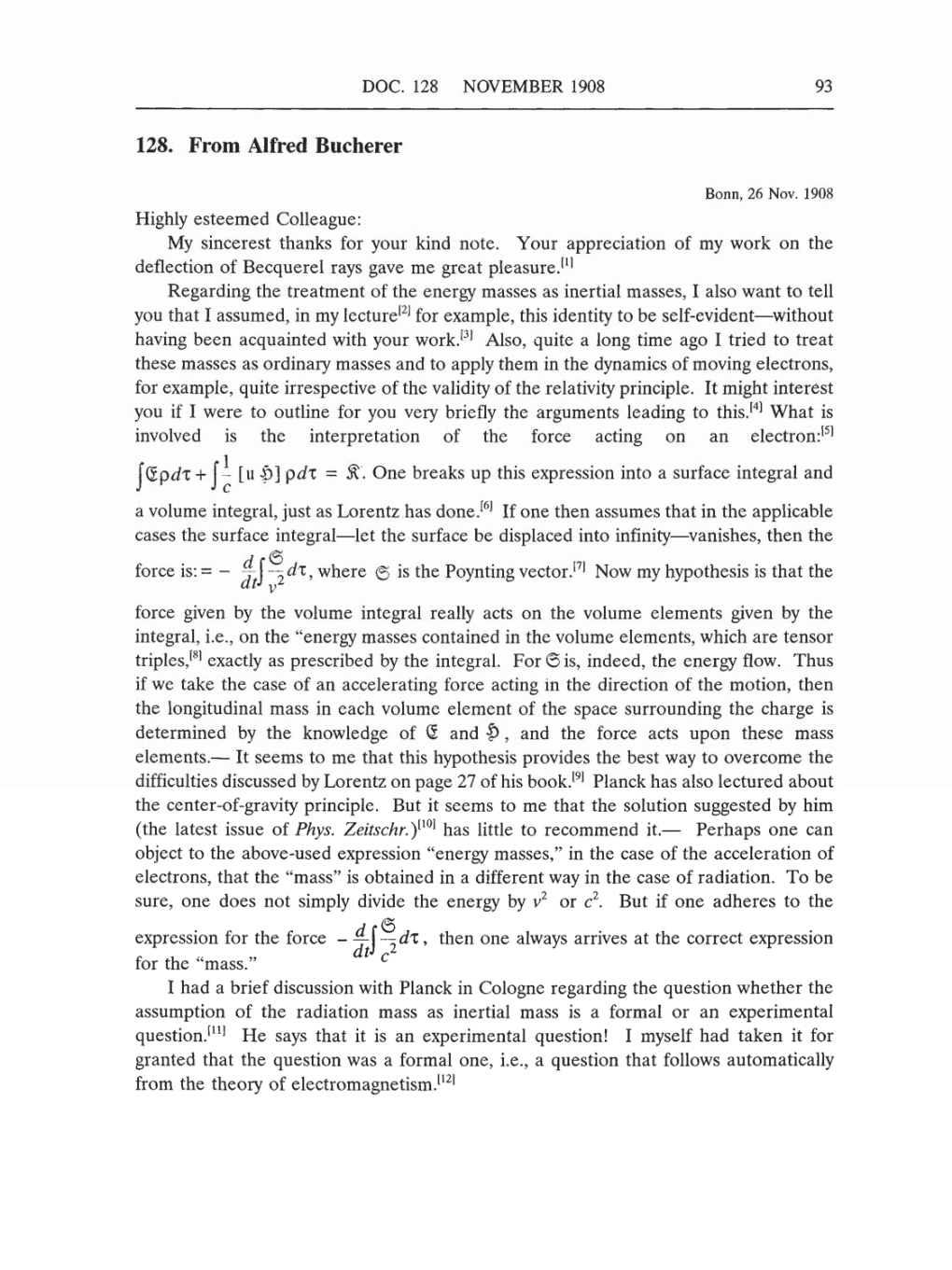DOC.
128
NOVEMBER
1908 93
128.
From
Alfred
Bucherer
Bonn,
26 Nov. 1908
Highly
esteemed
Colleague:
My
sincerest thanks
for
your
kind note.
Your
appreciation
of
my
work
on
the
deflection of
Becquerel
rays gave
me
great
pleasure.[1]
Regarding
the
treatment
of
the
energy
masses as
inertial
masses,
I also
want
to tell
you
that
I
assumed,
in
my
lecture[2]
for
example,
this
identity
to be
self-evident-without
having
been
acquainted
with
your
work.[3] Also, quite
a
long
time
ago
I
tried
to treat
these
masses as
ordinary
masses
and to
apply
them
in
the
dynamics
of
moving
electrons,
for
example,
quite irrespective
of
the
validity
of
the
relativity principle.
It
might
interest
you
if
I
were
to outline for
you very briefly
the
arguments leading
to
this.[4]
What
is
involved
is
the
interpretation
of the
force
acting
on an
electron:[5]
dx
+
f1-
[u |]
odx
=
Ä".
One breaks
up
this
expression
into
a
surface
integral
and
J
c
a
volume
integral, just
as
Lorentz
has
done.[6]
If
one
then
assumes
that
in
the
applicable
cases
the
surface
integral-let
the surface be
displaced
into
infinity-vanishes,
then the
i r
@
force
is:
=
d-dt
~
~2dx,
where
@
is
the
Poynting
vector.[7]
Now
my hypothesis
is
that
the
force
given by
the
volume
integral
really
acts
on
the
volume
elements
given
by
the
integral,
i.e.,
on
the
"energy masses
contained
in the volume
elements,
which
are
tensor
triples,[8] exactly as
prescribed
by
the
integral.
For
6
is,
indeed, the
energy
flow.
Thus
if
we
take the
case
of
an
accelerating
force
acting
in the
direction of the
motion,
then
the
longitudinal
mass
in
each
volume
element
of
the
space
surrounding
the
charge
is
determined
by
the
knowledge
of S
and
,
and the force
acts upon
these
mass
elements.- It
seems
to
me
that
this
hypothesis
provides
the best
way
to
overcome
the
difficulties discussed
by
Lorentz
on
page
27 of
his book.[9]
Planck has also
lectured about
the
center-of-gravity principle.
But it
seems
to
me
that the solution
suggested by
him
(the
latest
issue
of
Phys. Zeitschr.)[10]
has little
to
recommend it.-
Perhaps
one can
object
to
the
above-used
expression
"energy masses,"
in the
case
of
the
acceleration of
electrons,
that the
"mass"
is
obtained
in
a
different
way
in the
case
of radiation. To
be
sure,
one
does not
simply
divide the
energy
by v2 or
c2.
But if
one
adheres
to
the
j
ŧ
expression
for
the force
-
d-dt1
~^dx,
then
one
always
arrives
at
the correct
expression
for the "mass."
t
c
I
had
a
brief
discussion with Planck in
Cologne
regarding
the
question
whether the
assumption
of the radiation
mass
as
inertial
mass
is
a
formal
or an
experimental
question.[11]
He
says
that
it
is
an
experimental
question!
I
myself
had taken
it for
granted
that the
question
was a
formal
one, i.e.,
a
question
that
follows
automatically
from the
theory
of
electromagnetism.[12]
